Heritage Districts and Hard Times
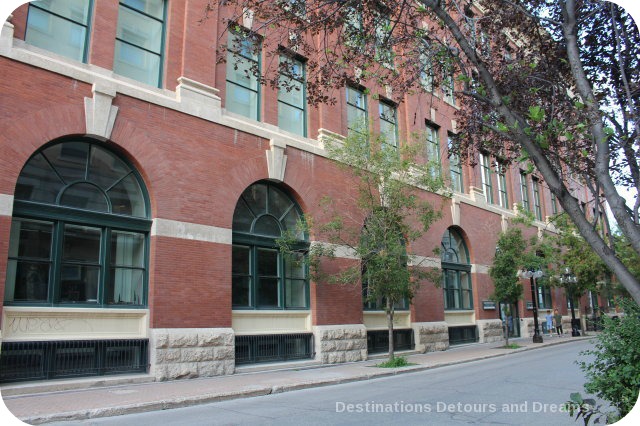
Examining the role of economic downturns in Heritage Districts
I’ve noticed a common theme in heritage districts I’ve visited in the United States and Canada. In many cases, the architecture wouldn’t exist today if the area had not gone through a period of depression.
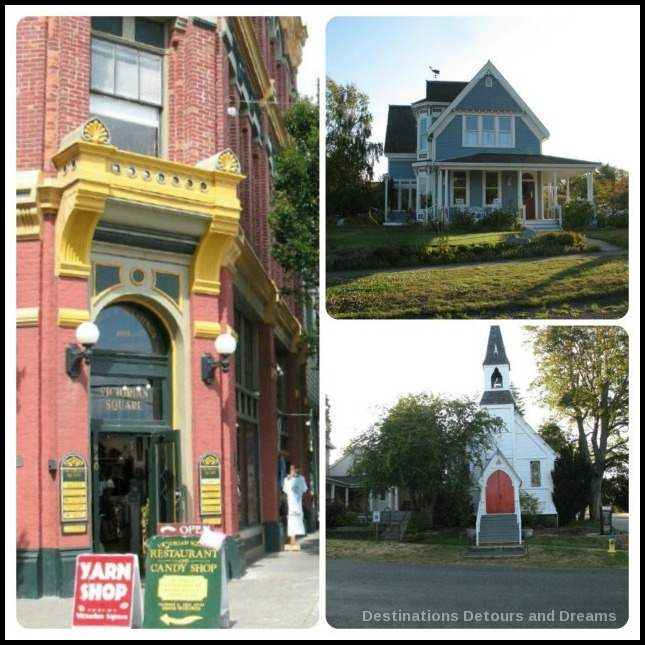
Port Townsend, Washington has many beautiful examples of Victorian architecture. It is one of three Victorian seaports listed on the U.S. National Register of Historic Places. The city, founded in 1851, was an important port and boomed during the 1880s. By the end of the nineteenth century, the boom was over. It was a time of economic depression and planned railway extensions into the town did not occur. Many people left the area. Revival began in the 1970s with an influx of people looking for affordable housing in a laid-back atmosphere. Today Port Townsend is a scenic and chic maritime city with a vibrant artist community. Many of the old Victorian buildings have been restored. But it is very likely these buildings would not exist today if it had not been for the hard times the city experienced. A store clerk told me the city didn’t have enough money to bulldoze the buildings.
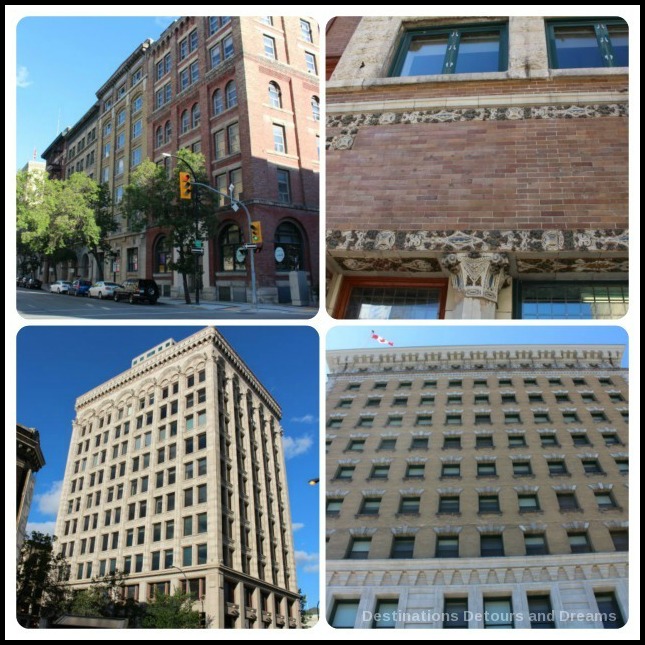
The Exchange District in my home city of Winnipeg, Manitoba is a Canadian National Historic Site. The twenty block area contains over 150 buildings dating to the late 1800s and early 1900s. Winnipeg was booming at that time. It was the Gateway to the West and a railway, banking, agricultural and manufacturing centre. The boom ended after World War I. The opening of the Panama Canal lessened the importance of the railway in getting goods to the west. Other western Canadian cities were growing and no longer relied as heavily on Winnipeg-supplied goods. When Winnipeg’s economy picked up again, businesses focused new building a few blocks south-west. The buildings in the Exchange were left alone. The area began a slow decline and became seedy. Today, the Exchange District is revitalized. It contains boutiques, restaurants, nightclubs, performance spaces, a thriving arts scene, businesses, residences and schools. If the area hadn’t gone through a decline or if the area had remained the business centre when the economy rebounded, many of these buildings may have been torn down to make way for something newer.
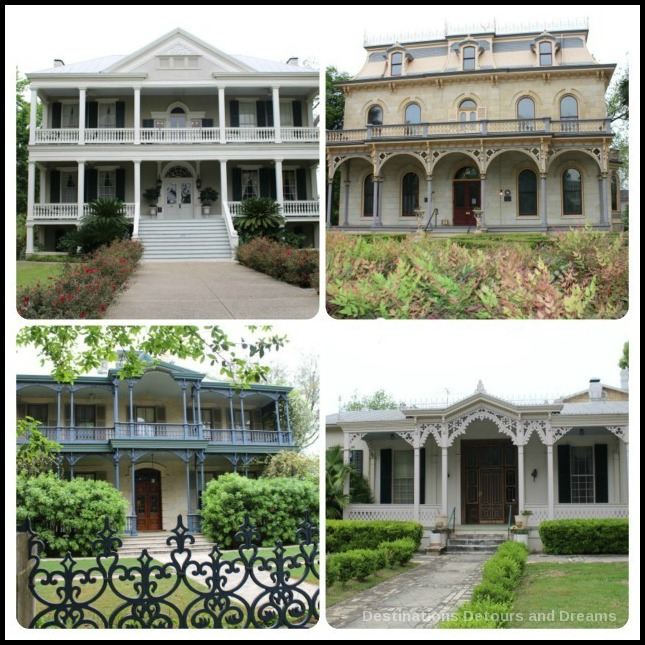
The King William Historic District in San Antonio, Texas has Greek Revival, Victorian and Italianate-styled homes dating to the 19th century. The area went into decline after World War II and fell into disrepair until preservationists began to restore homes later in the 1950s.
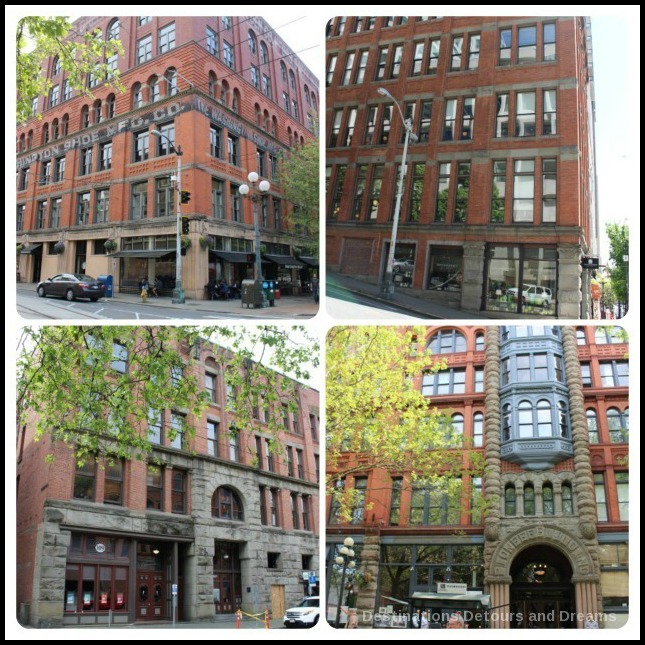
Pioneer Square is Seattle’s original neighbourhood, built in the second half of the 19th century. The area thrived as Seattle boomed. It went into decline after World War I. The Great Depression was particularly hard on this area. It became derelict and seedy. By the early 1960s, the business centre of Seattle had moved a few blocks north and a plan was formed to turn the area into a series of parking garages. The demolition of the Hotel Seattle in 1962 to create a parking garage nicknamed “the sinking ship” mobilized a historic preservation society. By 1970, Pioneer Square was Seattle’s first Historic District.
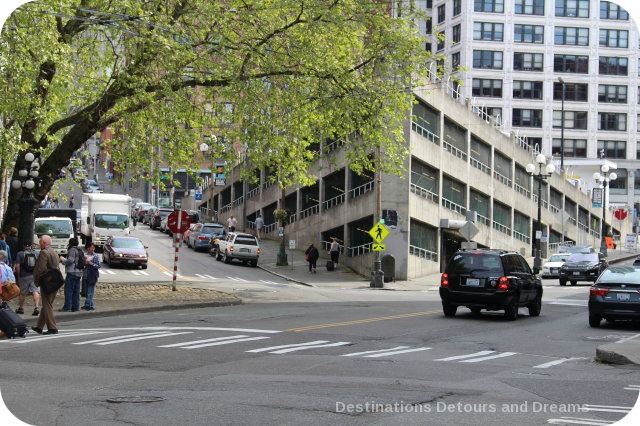
Today there is more of a focus on preserving heritage buildings and it can be hard to understand why they might have been destroyed. Historic buildings in Canada and the United States are young in comparison to the ages of buildings in many other parts of the world. Perhaps the relative newness lessened respect for a building’s heritage and made people more willing to replace it with something even newer. Abundance of land and space made it easy to expand or move to other locations.
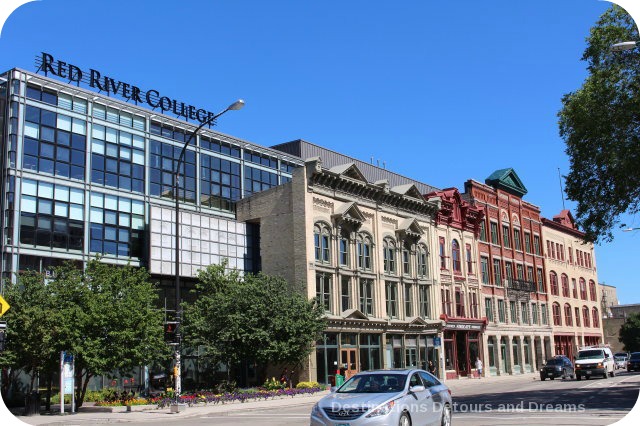
Red River College’s Exchange District campus is an interesting example of keeping the old and blending it with the new. The facades of several adjoining historic buildings in Winnipeg’s Exchange District have been preserved as the exterior of a new building which takes up the entire block. Other features of the original buildings are retained on the inside. Former brick exterior walls are now interior walls. Oak wainscotting, a quarry tile floor and an original tin ceiling have been retained in a vestibule entrance. Other original features in this modern campus include old stenciled vault doors, radiators and hardware.
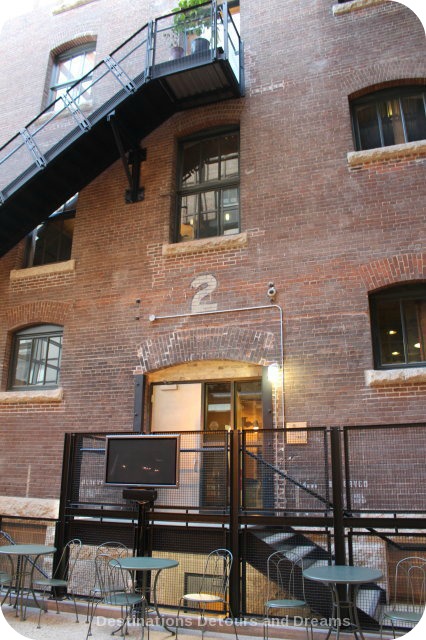
It is hard to predict what these heritage districts would look like now if depressions and economic downturns had not been part of their history. I wonder if something similar applies to our human lives. Have tough times helped preserve our own beauty and character?
I also wonder about newer buildings. What should we work to preserve?
The history of an area always interests me. But I now pay special attention to that of heritage districts. I am not surprised to learn the area went through a depressed time, a time when you wouldn’t have wanted to visit.
Destinations Detours and Dreams monthly e-newsletter contains behind the scenes information, sneak peeks ahead, travel story recaps and more. SIGN UP HERE
PIN IT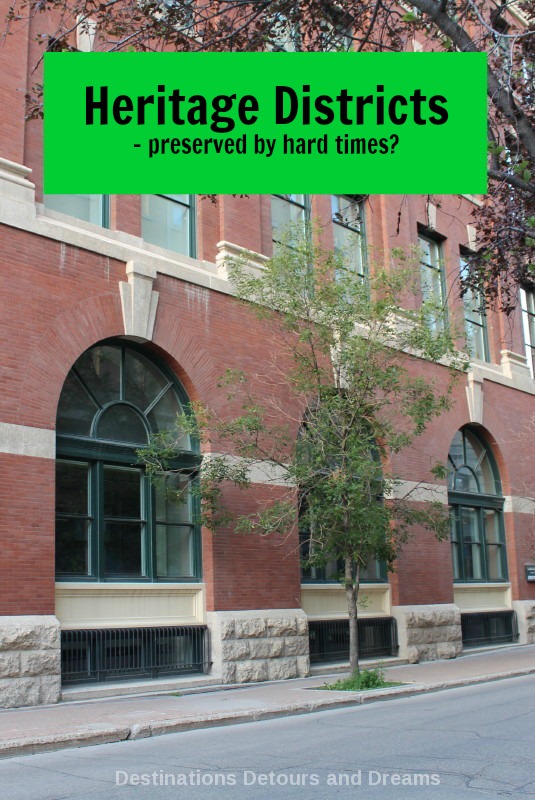


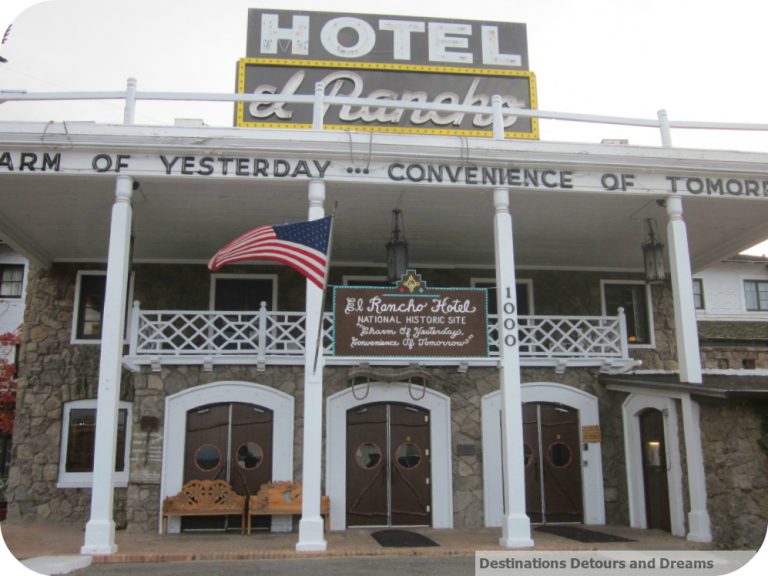



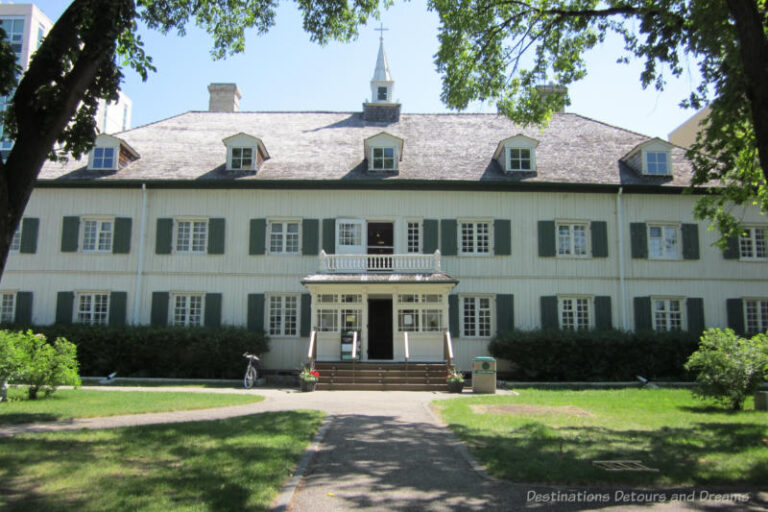
Great post, Donna! I guess neighbourhoods go through cycles. I’m always fascinated with gentrification — the area is depressed, usually it’s artists that move in first (sometimes squatting) leading to more attraction to the area. Then, the well-heeled lot take notice and start investing in the area, often pushing the artists out. I wonder if we’ll get better at protecting our architecture? It seems we need a hundred years distance to begin to appreciate buildings.
Thanks Deb. I am also fascinated by the change in neighbourhoods. You are probably right that it takes a lot of years of distance to appreciate architecture. I wonder what people will think are significant about buildings constructed today 150 years from now.
Many depressed towns and cities started on their way to revival by becoming arts communities. The low prices of previously abandoned buildings made them appealing to artists. Of course, once a revival comes to fruition, there’s always the possibility that the artists will get priced out. In New York City there are communities like Soho that once was known for art studios. Now it looks like a shopping mall full of tourists and there’s nary an artist in sight.
Interesting observation Ken. It does seem to be the artists who start a revival and when the revitalization of an area is successful they are often priced out of it.
Very interesting observation, Donna. How lucky that in many of these depressed towns they didn’t have the money to bulldoze the buildings. Can you imagine how many Victorian houses would have been lost forever? It takes a while for people to get to appreciate the old. The first temptation is to get rid of it.
Anda, I’m glad these Victorian houses remain. It does take a while for people to appreciate the old.
I agree with the interest in the Heritage areas of our cities. Pittsburgh has been hit and miss with which areas having truly had a boon versus the ones that struggle with the down trend and stay there. Beautiful pictures!
Thanks RoseMary. It’s tough when areas struggle with a down trend and stay there.
These are some great questions. I recently studied UNESCO’s World Heritage sites and how their designation caused some areas to suffer from nearby stores popping up to attract tourists. The Forbidden City, for example, became surrounded by numerous souvenir and tourist shops when it became a UNESCO World Heritage site and caused this area to lose it’s authenticity. Do I think buildings should not be preserved? I absolutely believe in preserving history, it’s a more complex issue than people think.
Brooke, definitely a complex issue. The UNESCO World Heritage designation has often helped spur building restoration while at the same time causing the issues with authenticity you point out.
So interesting to learn about the Heritage areas of our cities indeed. Beautiful photos, especially I liked parking in a form of a sinking ship. Simply genius, thanks for sharing
Glad you enjoyed the post.
It is interesting how you talk about these Heritage districts being preserved because of their times of depression. The economy is pretty good now where I live. And all the older, quaint Spanish style house that line the blocks where I live are being bulldozed down for these huge new, modern box shaped houses. The neighborhood literally has such a different feel than it did 5 years ago.
Erica, what a shame the quaint houses are being bulldozed. Are they in too bad a shape to be restored or is it just people wanting something newer (and maybe bigger)?
Thank you for sharing a bit of history with us. It is fascinating that neighbourhoods go through periods of poverty and challenges. There are several London towns I immediately think of which people once avoided like the plague. Now they are marketed as hip and the “place to be”- still as grimy and polluted as ever only now with overpriced housing!
Phoenicia, it is interesting how neighbourhoods change. It’s too bad, however, these hip places in London are still grimy and polluted.
Donna — totally agree that many areas need to experience a bust before a boom. Look at Harlem in New York City. In the 1920’s it was home to the city’s elites and beautiful brownstones and mansions were built. Then came a long period of decline. Over the past few years Harlem has experienced a Renaissance and these old buildings are being renovated and are commanding multi-million-dollar prices.
Jeannette, it’s interesting to hear about Harlem. I’ve never been to New York but what I heard about the Harlem area when I was younger meant I would have avoided it. It sounds as if those times have changed.
Oh I love roaming through heritage districts! I’ve been to Port Townsend and Seattle many times – just love Seattle Underground and all of the stories about the pioneer days. These are wonderful photos Donna and now that I’m living on the mainland I’m looking forward to a spring road trip to begin exploring the Pacific NW. Thanks for the inspiration!
Marquita, your spring road trip sounds like a lot of fun. It’s a great area that I haven’t had much opportunity to explore.
great post! I really enjoyed all the pictures of the heritage buildings, they really showcased the culture and aesthetics of that time. Thank you for sharing =)
Thanks Rosary.
Love the post Donna, Mumbai has very few of heritage buildings to offer in comparison to many other places.
Love heritage and knowing about it. Thank you for sharing dear!
Glad you enjoyed the post Sushmita.
I loved reading about the heritage areas and enjoyed the photographs. I love visiting at historical building and finding about the area and what the building were used for. In UK, I love visiting old cathedrals and churches as they can tell you so much about the area. Some of the areas around East London and the dock lands were really run down in the 60’s and 70’s and are now thriving with malls and expensive houses.
Thanks Mina. In last year’s visit to London, I saw the changes in the dock lands. Interesting how it is now an upscale, trendy area.
Your photos of the King William Historic District in San Antonio remind me of the local architecture in Uptown New Orleans, where I lived for the better part of twenty years. If you’ve never been to ‘the Big Easy’, you owe it to yourself to pay a visit sometime.
Andrew, I have not been to new Orleans, but the ‘Big Easy’ has been on my list of places I’d like to get to for some time. Hopefully I get there soon.
Fascinating post Donna and you pose some interesting questions. We’ve visited some of these heritage districts in San Antonio, around California and in Spokane and Seattle and even thought once about buying and restoring one of the grand, old Victorian homes when we lived in Butte, Montana. (We could have afforded the house but not the heating bill!) It’s extremely short-sighted when cities tear down these neighborhoods which offer glimpses into a not-so-distant past as well as provide some aesthetically pleasing, architectural diversity. Anita
Anita, I also think it is short-sighted to tear down neighbourhoods. Sadly, we don’t always appreciate the architecture until more time has passed. On the other hand, as you’ve mentioned, it can be expensive to maintain some of these grand old houses.